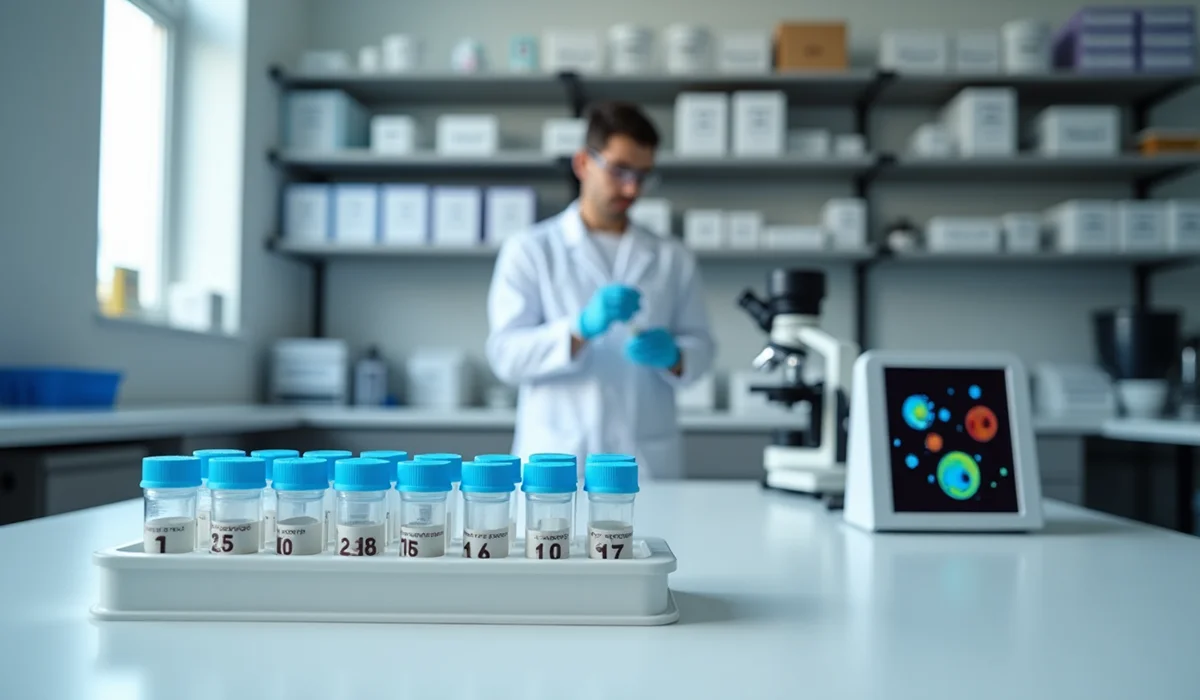Gut health problems can trigger symptoms way beyond the reach and influence of digestive issues. These include fatigue, rashes, joint pain, and maybe even mood swings. Learning about GI MAP tests is vital for people looking for answers about their gut health concerns. This FDA-approved diagnostic tool uses advanced quantitative PCR technology to analyze stool samples and gives an explanation of your gut microbiome.
The GI MAP test reviews the presence and quantities of various organisms in your gut. These include pathogens, fungi, beneficial bacteria, viruses, and parasites. It also detects antibiotic-resistant genes and reviews important markers of immune function, inflammation, and nutrient absorption. This complete analysis helps identify the mechanisms of digestive problems, inflammatory bowel disease, and autoimmune conditions.
This piece will get into how the GI MAP test works and what it reveals about your gut health. You’ll learn why it’s becoming a vital tool to understand overall wellness. We’ll also look at the testing process, result interpretation, and how this information can create individual-specific treatment plans for better health outcomes.
Quantitative PCR Technology Behind GI-MAP Testing
The GI-MAP test is different from conventional gut analysis methods. It uses quantitative polymerase chain reaction (qPCR) technology, which experts call “one of the most powerful and sensitive gene analysis techniques available” [1]. This molecular approach measures microbial DNA in stool samples with precision that goes way beyond the reach and influence of traditional testing methods.
qPCR vs traditional PCR: Diagnostic accuracy comparison
qPCR is different from standard PCR because it measures DNA in real-time throughout amplification. Standard PCR only quantifies DNA at the final stage, which makes true quantification impossible [1]. This vital difference lets the GI-MAP test report exact measurements instead of simple positive/negative results.
qPCR advantages over standard methods include:
- True quantification: Results show colony forming units per gram of stool (CFU/g), where one CFU roughly equals one microorganism [2]
- Higher accuracy: Detection and quantification are substantially more accurate than standard PCR, culture, microscopy, or DNA sequencing methods [1]
- Automation: The process runs fully automated and minimizes human error while maintaining high throughput [1]
- Reproducibility: GI-MAP’s consistent results are a great way to get treatment effectiveness data [1]
qPCR has become the industry standard faster because of its improved specificity, sensitivity, and reproducibility compared to conventional techniques.
DNA amplification thresholds for microbial detection
GI-MAP test’s remarkable sensitivity comes from sophisticated amplification and hybridization processes. The amplification creates thousands to millions of copies from a single target DNA sequence. This enables detection of tiny DNA quantities in stool specimens [1]. Single-stranded DNA from targets then binds to matching probes in a precise lock-and-key pattern.
The test’s detection threshold impresses with its ability to identify just 0.1 bacterial cells per gram of stool [2]. This sensitivity outperforms many competitive methods, especially when detecting organisms in low concentrations. The test’s analytical range measures both higher and lower genomic DNA amounts compared to other DNA analysis techniques [1].
Each target organism undergoes separate testing in duplicate to ensure accurate measurement [1]. This detailed approach helps practitioners separate trace levels of organisms from frank elevations that show active infections [1].
Sensitivity and specificity in pathogen identification
Studies of GI-MAP’s performance show mixed results for sensitivity and specificity. Research on spiked stool samples showed 80% sensitivity but only 26% specificity due to potential false positives [1]. Test developers challenge this finding. They argue that without proper gold-standard control, these “false positives” might be organisms that other methods missed [3].
qPCR method excels at detecting certain pathogens. To cite an instance, see how GI-MAP detects substantially lower levels of H. pylori in clinical samples compared to non-molecular detection assays [3]. Notwithstanding that, some limitations exist. PCR inhibitors, pH changes, protein concentrations, and primer affinity can affect results [1].
qPCR technology gives practitioners evidence-based data to make clinical decisions. Knowing how to measure exact amounts of microbial DNA helps distinguish between harmless colonization and problematic overgrowth. This leads to more targeted and effective treatment protocols [1].
Materials and Methods: How is a GI MAP Test Done?
The GI MAP test offers a simple process that lets patients collect samples at home privately. Learning about how a GI MAP test is done involves three key parts: collecting samples the right way, processing them in the lab, and getting a complete picture of various gut health markers.
Stool sample collection protocol and transport
Your healthcare provider will recommend a GI MAP test to assess your gut health concerns. You’ll receive a kit with everything you need:
- Specimen vial with preservative solution
- Collection tray
- Gloves
- Absorbent material
- Test request form
- Specimen bag
- Pre-paid shipping materials [4]
Here’s how to collect your sample:
- Label the specimen vial with your name, date of birth, and collection date
- Put on gloves and use the collection tray (best to urinate first to avoid contamination)
- Use the spoon attached to the vial cap to collect stool from at least four different areas
- Fill the vial above the indicated fill line without overfilling
- Important: Do not discard the pink preservative liquid in the vial [5]
- Mix well, tighten the cap, and shake vigorously for 30 seconds
Your samples need to reach the lab within 8 days [4]. You should refrigerate (not freeze) the sample if you can’t ship it right away. The best practice is to ship within 3 days of collection. Ship only Monday through Thursday to ensure proper handling upon arrival [6].
Lab processing workflow at Diagnostic Solutions
Diagnostic Solutions Laboratory analyzes the stool sample using quantitative polymerase chain reaction (qPCR) technology. This method provides true quantitative values, unlike microscopy and culture-based tests that have limitations with sensitivity and specificity, especially for anaerobic organisms [7].
The lab follows these steps:
- Sample preparation and DNA extraction
- DNA amplification using qPCR technology
- Measurement of target DNA sequences
- Quantification of results as colony forming units per gram (CFU/g)
- Comparison against established reference ranges [8]
This advanced molecular technique can detect microorganisms even at very low levels—as few as 0.1 cells per gram of stool [8]. The test results show whether pathogens exist in quantities that might cause disease rather than just their presence or absence.
Marker categories: Pathogens, immune, digestive, inflammation
The GI MAP test looks at several marker categories that help understand your gut function:
Pathogens: The test finds harmful bacteria (including H. pylori with virulence factors), parasites, and viruses that might cause gastrointestinal issues. It identifies specific bacterial pathogens like Campylobacter, C. difficile, E. coli variants, Salmonella, and parasites such as Giardia [8].
Normal Bacterial Flora: The test checks beneficial bacteria that your gut needs to function well [9].
Opportunistic Bacteria: It spots organisms that usually don’t cause harm in small amounts but can become problematic under certain conditions [9].
Fungi/Yeast: The test measures fungal organisms like Candida that might affect gut function [10].
Intestinal Health Markers: It checks several vital indicators:
- Digestive function (pancreatic elastase)
- Inflammation (calprotectin)
- Immune function (secretory IgA)
- Gut permeability markers [9]
Antibiotic Resistance Genes: The test uniquely spots genes that might affect treatment success, especially for H. pylori infections [11].
This all-encompassing approach gives healthcare providers practical data to create tailored treatment plans based on specific findings rather than symptoms alone [7].
Results and Discussion: What Does a GI MAP Test Show?
A GI MAP stool analysis shows nowhere near just pathogens—it gives you a complete picture of your gut ecosystem’s health and function.
Bacterial and fungal overgrowth patterns in test results
The GI MAP measures both beneficial and potentially harmful microorganisms. The test gets into pathogens like Campylobacter, C. difficile, E. coli variants, and Salmonella that can cause gastrointestinal symptoms [10]. The analysis also checks opportunistic bacteria that usually remain harmless in small amounts but become problematic during overgrowth [12]. These organisms can lead to symptoms like diarrhea, loose stools, abdominal pain, or even constipation when they grow excessively [13].
The GI MAP also identifies fungal organisms including Candida species. Fungi naturally exist in the digestive tract, but overgrowth can trigger problems especially when you have compromised gut health [13]. Identifying these imbalances helps practitioners create targeted treatment protocols.
Calprotectin and sIgA as inflammation and immunity markers
The test measures key markers that show gut inflammation and immune function:
- Calprotectin: This protein shows neutrophil-driven inflammation [14]. High levels might signal inflammatory bowel diseases like Crohn’s disease or ulcerative colitis. It helps distinguish between IBD and irritable bowel syndrome [9]. This marker serves as the “gold standard” to detect gastrointestinal inflammation.
- Secretory IgA (sIgA): This primary immunoglobulin at the digestive system’s border plays a vital role in mucosal immunity [10]. High levels often point to acute infection, chronic dysbiosis, food sensitivities, or acute stress [9]. Low levels suggest reduced mucosal health [8].
Zonulin and leaky gut correlation in GI MAP test results
Zonulin measurement comes as an optional add-on that makes the GI MAP better at assessing intestinal barrier function [2]. High zonulin levels show increased intestinal permeability, commonly known as “leaky gut” [15]. Bacteria, toxins, and undigested food particles can pass through the intestinal barrier and trigger immune responses [2].
Research links high zonulin with various conditions including celiac disease, Crohn’s disease, ulcerative colitis, autoimmune diseases (rheumatoid arthritis, multiple sclerosis, lupus), and maybe even certain neurological disorders [2]. Practitioners look for infections that cause inflammatory processes when zonulin runs high [2].
Antibiotic resistance gene detection and clinical relevance
The GI MAP includes a complete antibiotic resistance genes panel that finds 55 genetic elements linked to resistance against 10 different antibiotic classes [16]. Multidrug resistance poses one of the most important public health threats—causing about 35,000 deaths yearly in the United States [16].
Detected resistance genes help practitioners customize treatment approaches better. The presence of these genes indicates avoiding certain antibiotic classes as first-choice treatments [16]. Bacteria can share DNA faster under stress, so resistance in any organism gives enough reason to avoid that particular drug class [13].
Clinical Applications and Diagnostic Use Cases
The clinical value of what a GI MAP test shows goes way beyond simple gut analysis. These tests give an explanation about many chronic health conditions that seemed unrelated to digestive function.
Autoimmune disease correlation: Hashimoto’s, IBD, Celiac
Research confirms that intestinal permeability links to every case of autoimmunity [17]. The GI-MAP test serves as a vital diagnostic tool for practitioners who work with autoimmune conditions. Nearly 90% of Hashimoto’s patients who hit a plateau in their healing experience have gut infections or microbiome imbalances [17]. H. pylori shows up regularly as a common trigger for both Hashimoto’s and Graves’ disease [17]. Other microbes like MAP (Mycobacterium avium subsp. paratuberculosis) play a role in Crohn’s disease development [1].
The test measures specific autoimmune triggers such as Klebsiella pneumoniae, Mycobacterium avium, cytomegalovirus (CMV), and Epstein-Barr Virus (EBV) [1]. Dysbiosis combined with elevated zonulin levels creates a distinct pattern for autoimmune processes. This allows practitioners to develop individual-specific treatment protocols that address why it happens rather than just managing symptoms [1].
Mood disorders and gut-brain axis insights from GI-MAP
The gut-brain connection works as a two-way communication system with neural, hormonal, and immune pathways [18]. GI-MAP testing reveals significant data about this relationship. It shows how gut bacteria produce neurotransmitters like serotonin, dopamine, and GABA that affect mood, sleep, and cognitive functions directly [18].
Patients with neurological conditions benefit greatly from this test. Chronic inflammation or harmful bacteria in the gut can worsen symptoms like brain fog, cognitive decline, and mood disturbances [19]. GI-MAP findings help practitioners develop targeted approaches to address imbalances that contribute to these neurological manifestations.
SIBO and dysbiosis patterns in chronic GI symptoms
GI-MAP complements traditional SIBO breath testing by providing a deeper assessment of gastrointestinal health [20]. Symptoms that don’t fully resolve despite reasonable SIBO protocols often point to underlying factors that breath tests miss [20]. The GI-MAP identifies hydrogen sulfide-producing organisms and other confounding factors in SIBO cases [20].
Stubborn cases need GI-MAP’s investigation into gut ecology, microbiome status, and digestive function. This creates a full picture that addresses everything in gut dysfunction instead of just focusing on bacterial overgrowth [20].
Limitations of GI-MAP Testing in Clinical Practice
GI-MAP testing gives great insights into gut health, but we need to know its limitations to use it properly in clinical practice. The advanced technology has several constraints that affect how well it works in clinical settings.
False positives and negatives in qPCR-based stool tests
Research has questioned the accuracy of what is a gi map test results. A study showed the GI-MAP had 80% sensitivity but only 26% specificity because of many false positive results [3]. These findings raise concerns about potential risks of overtreatment, since doctors might prescribe antibacterial or antiparasitic agents when no real pathogens exist [3]. Test manufacturers argue that without a proper gold-standard control, these apparent “false positives” might actually be organisms that other testing methods missed [21]. Whatever the case, doctors should know that detection below “threshold of normal” can be misleading and likely shows assay background instead of actual pathogen presence [3].
Sample variability and reproducibility concerns
Stool’s mixed nature creates challenges for consistent testing. The way samples are collected substantially affects results—getting samples from toilet paper can contaminate them with skin microbiome and miss bacterial clusters in stool [22]. Different stool densities between samples can lead to varying results even from the same specimen [23]. So doctors should know that different results from split samples might show sampling differences rather than test inaccuracy. The manufacturers say all organisms measured by qPCR on the GI-MAP have less than 10% coefficient of variation, though CLIA allows for 15% [24].
Cost and insurance coverage limitations
Money is a big barrier to GI-MAP testing. These tests cost between $500-$700 [25], which hits patients hard when they don’t have insurance coverage. Most health insurance policies don’t cover these tests [26] because many insurance companies haven’t recognized their clinical value yet [27]. Patients need out-of-network benefits and a doctor’s diagnosis of a gut-related condition to even think about reimbursement [27]. The success rates for insurance coverage stay low even with these requirements [27]. So patients often must choose between paying from their pocket or skipping this potentially valuable diagnostic information.
Conclusion
GI-MAP testing works as a powerful diagnostic tool that helps us learn about complex gut health problems. Medical practitioners need to balance its advantages and limitations carefully. The test uses advanced qPCR technology and gives a complete analysis. It shows detailed information about pathogens, beneficial bacteria, inflammation markers, and immune function indicators.
Medical experts now know gut health plays a vital role beyond digestive symptoms. This becomes even more important with autoimmune conditions and neurological health. The test detects antibiotic resistance genes and measures intestinal permeability. These features make it valuable to develop targeted treatment protocols.
Medical practitioners need to think about several factors before they recommend GI-MAP testing. The test provides unprecedented detail about gut microbiome composition. Questions about false positives and sample variability need attention. High out-of-pocket costs might prevent many patients from accessing this test.
GI-MAP testing remains valuable for patients who need answers about ongoing gut-related symptoms. This becomes more relevant when standard tests fail to identify the mechanisms behind their problems. The advanced diagnostic tool combined with clinical expertise helps create tailored treatment approaches. These approaches lead to better gut health outcomes.
References
[1] – https://www.diagnosticsolutionslab.com/blog/autoimmune-diseases-how-get-bottom-problem
[2] – https://www.diagnosticsolutionslab.com/blog/understanding-and-managing-elevated-zonulin-levels-insights-gi-map
[3] – https://pmc.ncbi.nlm.nih.gov/articles/PMC7660239/
[4] – https://www.diagnosticsolutionslab.com/collection-instructions
[5] – https://truehealthlabs.com/gi-map-stool-test-collection-instructions/
[6] – https://support.rupahealth.com/en/articles/8552798-gi-map
[7] – https://www.diagnosticsolutionslab.com/tests/gi-map
[8] – https://www.diagnosticsolutionslab.com/assets/documents/gi-map-interpretive-guide.pdf
[9] – https://www.rupahealth.com/lab-tests/diagnostic-solutions-gi-map
[10] – https://www.diagnosticsolutionslab.com/assets/documents/gi-map-white-paper.pdf
[11] – https://www.designsforhealth.com/learn-more/gi-map?srsltid=AfmBOorGmY5Sx1OR7gB34jndPbWE7wgrC9FbWLZ8QfnGILjw9-Wsno2U
[12] – https://www.rupahealth.com/post/gi-map-result-interpretation-101
[13] – https://www.eaglevisionnutrition.com/gi-map-comprehensive-stool-analysis/
[14] – https://www.gdx.net/products/gi-effects
[15] – https://austinmdclinic.com/gi-map-testing-revealed/
[16] – https://www.diagnosticsolutionslab.com/blog/universal-antibiotic-resistance-genes
[17] – https://thyroidpharmacist.com/articles/gi-map-test-to-find-your-root-cause/
[18] – https://www.diagnosticsolutionslab.com/blog/the-importance-of-functional-stool-testing-in-babies-linking-gut-microbiota-growth-with-brain-development
[19] – https://www.drjamieahn.com/g-i-map-stool-test-diagnostic-solutions/
[20] – https://www.drkarafitzgerald.com/2021/04/01/beyond-breath-testing-using-the-gi-map-to-uncover-the-other-players-in-sibo/
[21] – https://www.diagnosticsolutionslab.com/blog/response-doctors-data-inc-ddi-funded-study
[22] – https://www.drcarlynd.com/blog-posts/best-stool-test
[23] – https://www.diagnosticsolutionslab.com/blog/gi-map-inaccurate-we-think-not
[24] – https://www.ginabhealthy.com/wp-content/uploads/2022/05/GI-MAP-Methodology-Guide.pdf
[25] – https://casadesante.com/blogs/gut-health/is-gi-map-test-covered-by-insurance?srsltid=AfmBOoq0Dbp0NA_DpHse2l7tXdoYywF2xbxeBcHp_AakwjimUcqms91n
[26] – https://www.gimapping.com/blog/breaking-down-the-gi-map-cost-what-clients-pay-for-and-why
[27] – https://wonderfullymadenutrition.com/gi-map-test-2/




